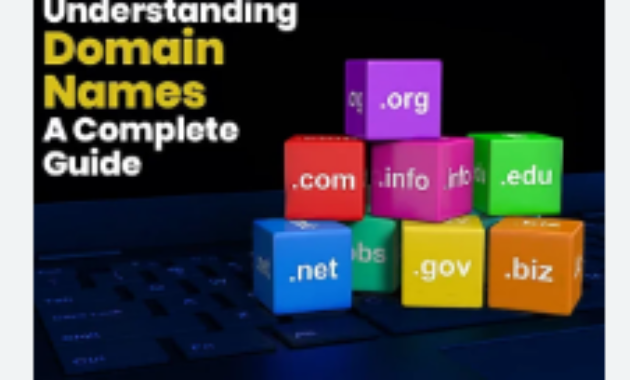In the digital age, domains are fundamental to establishing an online presence. Whether you’re starting a personal blog, launching a new business, or managing a large enterprise, understanding domains is crucial. This guide provides a thorough overview of what domains are, their importance, and how to manage them effectively.
Table of Contents
What is a Domain?
A domain is a unique address used to identify a website on the internet. It is essentially the textual representation of an IP address, which is a numerical label assigned to each device connected to a network. Domains make it easier for users to find and access websites without needing to remember complex numerical IP addresses.
A domain name typically consists of two main parts:
- Second-Level Domain (SLD): This is the part of the domain name that comes before the top-level domain. For example, in “example.com,” “example” is the SLD.
- Top-Level Domain (TLD): This is the suffix at the end of the domain name, such as “.com,” “.org,” or “.net.”
Types of Domains
- Top-Level Domains (TLDs): TLDs are the last part of a domain name and are categorized into several types:
- Generic Top-Level Domains (gTLDs): These include popular TLDs like “.com,” “.org,” and “.net.” They are used for general purposes and are not tied to specific countries or regions.
- Country Code Top-Level Domains (ccTLDs): These are specific to countries or territories, such as “.uk” for the United Kingdom, “.jp” for Japan, or “.ca” for Canada.
- Sponsored Top-Level Domains (sTLDs): These are specialized TLDs sponsored by specific organizations or communities, such as “.edu” for educational institutions or “.gov” for government entities.
- Subdomains: Subdomains are extensions of the main domain and are used to organize or separate different sections of a website. For example, “blog.example.com” is a subdomain of “example.com.”
The Importance of Domains
- Brand Identity: A domain name is a crucial component of your online brand identity. It reflects your business name or personal brand and can influence how users perceive and remember your website.
- Credibility and Professionalism: Having a custom domain name enhances your credibility and professionalism compared to using a generic subdomain provided by web hosting services. It shows that you are serious about your online presence.
- Search Engine Optimization (SEO): A well-chosen domain name can impact your SEO efforts. Including relevant keywords in your domain name can help improve your website’s visibility in search engine results.
- User Experience: A memorable and easy-to-type domain name improves user experience by making it simpler for visitors to find and return to your website.
How to Choose a Domain Name
- Keep It Simple and Memorable: Choose a domain name that is easy to spell, pronounce, and remember. Avoid complex words or phrases that might confuse users.
- Incorporate Keywords: Including relevant keywords in your domain name can help with SEO and give users an idea of what your website is about.
- Avoid Hyphens and Numbers: Hyphens and numbers can make your domain name harder to remember and can lead to confusion. Stick to letters for a cleaner, more professional appearance.
- Check Availability: Before finalizing your domain name, check its availability using domain registration tools. Ensure that the domain you want is not already in use or trademarked.
- Consider Your Brand: Choose a domain name that aligns with your brand’s identity and future goals. It should be flexible enough to accommodate potential growth or changes.
Registering and Managing a Domain
- Choose a Domain Registrar: A domain registrar is a company authorized to register domain names. Popular registrars include GoDaddy, Namecheap, and Google Domains. Choose a reputable registrar that offers good customer support and competitive pricing.
- Register Your Domain: Once you’ve chosen a domain name, register it through your selected registrar. You will need to provide contact information and select the registration period, which is usually between one to ten years.
- Domain Privacy Protection: Consider opting for domain privacy protection to keep your personal contact information private. This service masks your contact details in the public WHOIS database.
- Renewal and Expiration: Domains need to be renewed periodically to maintain ownership. Set up automatic renewal if possible to avoid accidental expiration and loss of your domain.
- DNS Management: Domain Name System (DNS) management involves configuring your domain’s DNS settings to point to your website’s hosting server, email services, and other resources. Your domain registrar typically provides a DNS management interface for these settings.
Conclusion
Domains are a fundamental aspect of establishing a strong online presence. Understanding what domains are, how they work, and how to manage them effectively is crucial for businesses, organizations, and individuals alike. By choosing a memorable and relevant domain name, registering it with a reputable registrar, and maintaining it properly, you can enhance your online brand, improve user experience, and support your digital goals. As the internet continues to evolve, staying informed about domain management practices will help ensure your online presence remains robust and effective.
Common Domain-Related Issues and Solutions
Managing domains can sometimes present challenges. Here are some common issues and solutions to help you navigate potential problems:
1. Domain Name Disputes
Issue: Disputes over domain names can arise if someone claims that your domain infringes on their trademark or if there is a disagreement over domain ownership.
Solution:
- Trademark Search: Before registering a domain, conduct a trademark search to ensure it does not infringe on existing trademarks.
- Legal Assistance: If a dispute arises, seek legal advice to understand your rights and options. Many domain registrars offer dispute resolution services or can guide you through the process.
2. Domain Expiration
Issue: If a domain is not renewed on time, it may expire, leading to potential loss of ownership or downtime for your website.
Solution:
- Set Up Auto-Renewal: Enable auto-renewal features with your domain registrar to avoid missing renewal deadlines.
- Renew Early: Renew your domain well before its expiration date to prevent any lapses in registration.
3. DNS Propagation Delays
Issue: When making changes to your DNS settings, such as updating your website’s hosting or email configuration, these changes can take time to propagate across the internet.
Solution:
- Be Patient: DNS changes can take anywhere from a few hours to 48 hours to fully propagate. During this period, some users may see the old settings while others see the new ones.
- Monitor Changes: Use online tools to check the status of your DNS propagation and verify that changes are being applied correctly.
4. Domain Theft
Issue: Domain theft occurs when someone gains unauthorized access to your domain account and transfers the domain to another registrar or owner.
Solution:
- Enable Domain Locking: Activate domain locking (also known as registrar lock) to prevent unauthorized transfers.
- Use Strong Passwords: Secure your domain registrar account with strong, unique passwords and enable two-factor authentication if available.
- Monitor Account Activity: Regularly review your account for any suspicious activity or changes.
5. SEO Impact from Domain Changes
Issue: Changing your domain name or URL structure can impact your website’s SEO, potentially leading to a loss in search engine rankings.
Solution:
- Redirects: Implement 301 redirects from your old domain or URLs to the new ones to ensure users and search engines are directed to the correct pages.
- Update Backlinks: Update any backlinks pointing to your old domain with your new domain information where possible.
- Notify Search Engines: Use Google Search Console and other webmaster tools to inform search engines of the domain change and monitor the impact.
Future Trends in Domain Management
As technology and the internet continue to evolve, several trends are shaping the future of domain management:
1. Emergence of New TLDs
New TLDs are continually being introduced, offering more options for domain names. This expansion provides greater opportunities for creating unique and relevant domain names for various industries and niches.
2. Increased Focus on Security
With growing concerns about cyber threats, there is a heightened focus on domain security. Innovations such as DNSSEC (Domain Name System Security Extensions) and improved WHOIS privacy protections are becoming more prevalent to enhance domain security.
3. Integration with Emerging Technologies
Domains are increasingly integrated with emerging technologies such as blockchain and decentralized web technologies. These integrations aim to enhance domain ownership verification, security, and management.
4. Personalized Domain Extensions
Custom TLDs, allowing for highly personalized domain extensions (such as “.yourbrand” or “.yourname”), are becoming more popular. These personalized domains offer unique branding opportunities and can help businesses stand out in a crowded online space.
Conclusion
Domains are more than just web addresses; they are integral to your online identity and success. By understanding the fundamentals of domains, choosing the right domain name, and effectively managing domain-related issues, you can build a strong and credible online presence. Staying informed about trends and best practices in domain management will ensure that you leverage your domain effectively, adapt to technological advancements, and maintain a competitive edge in the digital landscape. Whether you are an individual, a small business, or a large organization, a well-managed domain is a key asset in achieving your online goals.




